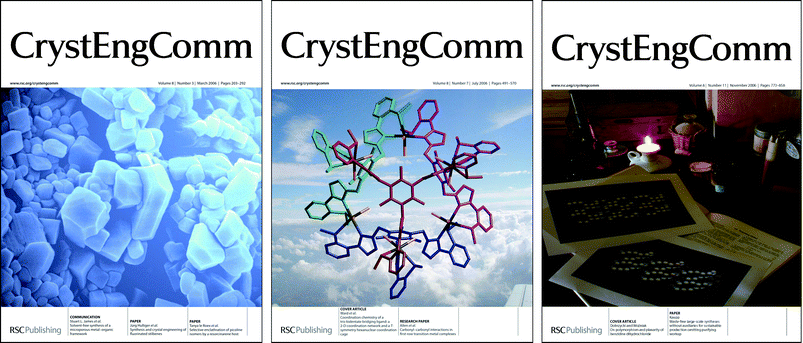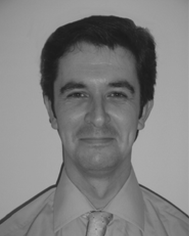CrystEngComm—continuing to grow
Jamie Humphrey
CrystEngComm continues to grow from strength to strength. The successful launch of monthly issues in 2006 was a significant, and very popular, development for the journal. Alongside the monthly issues, the journal now features cover images (see the Cover Gallery at http://www.rsc.org/Publishing/Journals/ce/Gallery.asp and Fig. 1 for some examples). | ||
| Fig. 1 Some eyecatching covers appearing on CrystEngComm in 2006. | ||
The 2005 impact factors, released by ISI® in June 2006, showed an impressive average increase of over 10% for RSC Journals. We were delighted to see that the impact factor for CrystEngComm increased by 35%, to 3.508, the highest impact factor the journal has ever had. At the same time, the journal's immediacy index increased by over 50%, to 0.723, showing that the science published in the journal is amongst the most topical! These impressive new figures reinforce the RSC's reputation as the home of exciting new research. Calculated annually, ISI® impact factors provide an indication of the quality of a journal—they take into account the number of citations in a given year for all the citable documents published within a journal in the preceding two years. The immediacy index measures how topical and urgent papers published in a journal are, by dividing the number of citations in a given year by the number of articles published in the journal that year.
After many years at the helm of the journal, we say good bye to Professor Dario Braga as Scientific Editor of the journal. Dario played a fundamental part on the launch of the journal in 1999, and since that time has continued to provide his advice and guidance to the journal with his typical enthusiasm! We also bid a fond farewell to Professor Lee Brammer, whose term of office as Chair of the Editorial Board ends at the end of 2006. Lee has helped to oversee the transition of the journal from a new start-up journal to a more established journal.
We are delighted to announce that Neil Champness (Nottingham, UK) will become Chair of the Editorial Board from January 2007. Neil has been a member of the Editorial Board since 2002, and has a very good understanding of the journal, and crystal engineering community which the journal aims to serve. We wish him well in his new role as Chair of the CrystEngComm Editorial Board.
We thank retiring members of the Advisory Board, Professors Dance, Schroder, Hosseini and Toda for their efforts to develop the journal during the past few years, as well as providing support for the journal. We also welcome to the Editorial Office in Cambridge Drs May Copsey and Freya Means. May joins us from the Professor Tristram Chivers group at the University of Calgary, where she worked on metal telluride thin-films, after finishing her PhD studies at Bristol University, UK. Freya completed her PhD studies at the University of New South Wales with Professor Justin Gooding, on the topic of DNA biosensing.
Enhancing our services for readers
In 2007 we will see an exciting new development for CrystEngComm, the launch of theme issues. The two themes that will be published in 2007 will be on the themes of biomineralisation (Guest Editor Professor Lia Addadi, Weizmann Institute, Israel) and advancing materials by chemical design (Guest Editor Professor Neil Champness, Nottingham, UK). These theme issues will showcase the latest research in these areas, and will be an invaluable resource for researchers in the field.2006 has seen RSC Publishing invest significantly in technological developments across all of its products. Introduced last year, RSS feeds, or ‘really simple syndication’, have proved extremely popular with our readers. Subscribers receive alerts as soon as an Advance Article is published in their journal of choice, providing both the graphical abstract and text from a journal's contents page. You can subscribe to RSS feeds via the CrystEngComm homepage.
Subscribers to CrystEngComm will now link from journals' contents lists straight through to the HTML view of selected articles, in just one quick step. Here you can download references to citation managers (such as EndNote, Ref Manager, ProCite and BibTex), sign up for RSS feeds, search for citing articles (otherwise known as ‘forward linking’), print the article with just one click and send the article to a friend or colleague.
From 2007, authors publishing in RSC journals will see their science “come alive” thanks to an exciting new project pioneered by the RSC. Enhanced HTML in RSC articles will allow chemical and biological compounds mentioned in the text to be identified; by clicking on the compound readers will be able to obtain further information about that compound, including a downloadable structure plus a list of relevant subject areas. The RSC is the first publisher to utilise the International Chemical Identifier (InChI) (a digital equivalent of the IUPAC name for any particular covalent compound where structures are expressed in terms of five layers of information—connectivity, tautomeric, isotopic, stereochemical, and electronic) for a project of this type and scope. The technology will be used to enhance RSS alerts so that future news feeds can include chemical structures and other enhanced information. RSC Publishing intends to evolve this project to match author and reader needs so tell us what you think: we welcome your feedback on this new functionality and will incorporate your ideas to develop the service further. Find out more at http://www.rsc.org/sciencecomealive. These developments demonstrate the investment in publishing products and services over the past year and 2007 will see us enhancing our products further.
Enhancing our services for authors
Authors publishing in RSC Journals now have the option of paying a fee in exchange for making their accepted communication, research paper or review article openly available to all via the web, with RSC Open Science. The scheme is only made available to authors once their papers have been accepted for publication, following the normal rigorous peer-review procedures (RSC Open Science operates in parallel with the normal publication route, which remains free to authors). Authors who have published their work in RSC journals will also be able to retrospectively apply for their work to be included in the scheme. Further information can be found at: http://www.rsc.org/openscienceWe are always happy to receive feedback from authors, especially if it helps us to further improve the publishing experience. Because we believe that RSC Publishing offers the best service of any scientific publisher, we have published a selection of the comments we have received from authors from around the globe—take a look at http://www.rsc.org/authorquotes
CrystEngCommunity
CrystEngCommunity, the journal's sister website, continues to add more features for the WorldWide crystal engineering community. 2006 saw the launch of a conference diary, CrystEngSelects (a regularly updated selection of articles of interest to crystal engineers from across the RSC journals) and CrystEngWiki, a web encyclopedia for crystal engineers, for crystal engineering terminology. All are available via the CrystEngCommnity website http://www.rsc.org/Publishing/Community/RSCPublishing news
In 2006, RSC Publishing awarded more than 20 prizes and sponsored lectureships to high-profile researchers. The recipients gained financial support to present and discuss their work at events throughout the world, in recognition of their research achievements. More than £15 000 (or $30 000) was granted to the recipients, in total, to cover travel expenses to sponsored lectureships in countries such as China, Japan, US and UK.Showcasing hot science from RSC Journals in Chemical Science, Chemical Technology and Chemical Biology has proved very popular with readers and authors alike. In fact, the free supplements have become so successful that from January 2007, all issues will be eight pages (in print), contain new article types and come complete with a fresh new look for the front page. Supplementary material will also be available online.
Meanwhile Chemistry World, the RSC's award-winning magazine, launched two new web features at the end of 2006. The Chemistry World Blog is an interactive forum for news, discussion and opinion, looking at the science hitting the headlines. The Chemistry World Podcast interviews high profile scientists about the latest and hottest topics in science, and is free to download at http://www.rsc.org/chemistryworld
Nanoscience is one of the rapidly developing areas of scientific research. Due to the interdisciplinary nature of the subject many RSC journals and books include related content. This wealth of nano material has now been brought together in one convenient webpage, which is regularly updated with the latest research and books from RSC Publishing. Visit: http://www.rsc.org/publishing/journals/nanoscience/
As well as an impressive portfolio of prestigious journals, the RSC has a wide selection of products for anyone with an interest in the chemical sciences. Visit the shop at http://www.rsc.org/shop to browse over 400 book titles, subscribe to or purchase an individual article from CrystEngComm or any other RSC journal, join or renew RSC membership, or register to attend a conference or training event.
In addition, RSC Publishing is pleased to announce the launch of the RSC eBook Collection. RSC books are now available online and can be easily downloaded as either chapters or books. The collection is fully searchable and also integrated with RSC Journal content. To search the collection or for further information, visit http://www.rsc.org/ebooks
CrystEngComm continues to grow and develop, to meet the needs of the crystal engineering communities. Comments and suggestions for the journal's growth are welcome—please email the Editorial Office.
CrystEngComm profiles Professor Neil Champness, the new Chair of the CrystEngComm Editorial Board
 | ||
| Plate1 Neil R. Champness | ||
| This journal is © The Royal Society of Chemistry 2007 |
